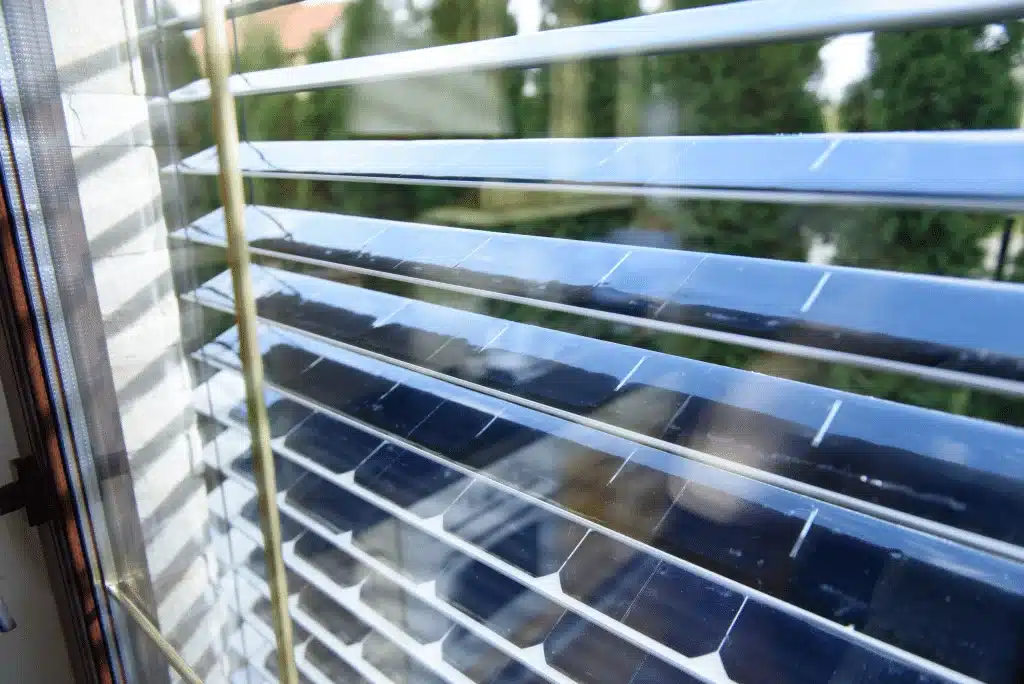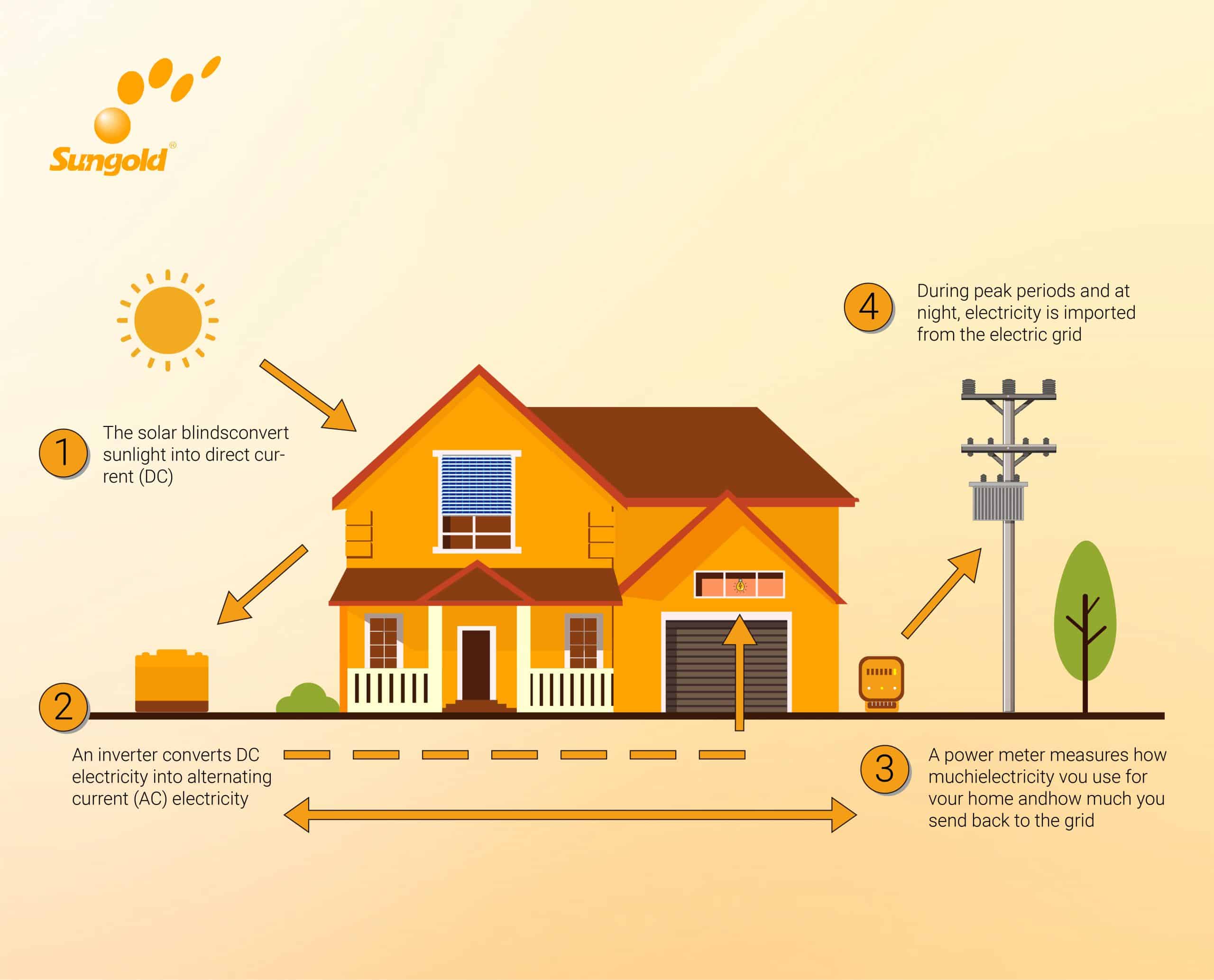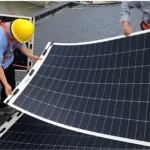Table of Contents
- What Are Solar Blinds?
- The Function of Solar Blinds / Shades?
- Do Solar Blinds Block UV Rays?
- Do Solar Blinds Endure Different Weather Conditions?
- Do Solar Blinds Reduce Heat?
- How Do Smart Solar Blinds Work?
- How Much Energy Can Solar Blinds Generate?
- What Are the Advantages of Solar Blinds Compared to Regular Solar Panels?
- Why Would You Want A Solar Blind?
- Where Do Solar Blinds Work Best?
Solar panel blinds are an innovative green technology that provides a new way to embrace environmental sustainability by converting solar energy into electricity. These unique shading devices transform traditional solar panels into functional window blinds, combining the dual benefits of shading and power generation. Solar panel blinds retain all the advantages of traditional solar panels while offering added convenience and practicality.
As a one-stop provider of solar panel blind solutions, we proudly possess comprehensive knowledge about this groundbreaking product. Whether you are curious about the applications, working mechanisms, or the reasons why solar panel blinds might be the ideal choice for you, we have detailed information ready. Stay tuned as we present everything you need to know about solar panel blinds.
Table of Contents
What Are Solar Blinds?
In short, “solar panel blinds” are essentially battery-powered electric blinds that charge using solar energy instead of traditional batteries or grid electricity. Since solar panels come in various types, there are multiple versions of these shading systems as well. Therefore, it is important to distinguish between regular solar blinds and solar panel blinds.
So, what exactly are solar panel blinds? Also known as solar blinds, they are essentially solar panels transformed into window shades. They fall under the category of photovoltaic (PV) systems because they convert solar energy into electricity. This allows solar panel blinds to help you save up to 70% on electricity bills. For those who cannot or prefer not to install rooftop solar panels to reduce their monthly utility bills, smart solar panel blinds offer the most economical and efficient solution.

The Function of Solar Blinds / Shades?
Solar panel blinds incorporate all the advantages of converting solar energy into electricity, along with the associated challenges. However, this innovative shading solution goes a step further by effectively addressing traditional drawbacks of photovoltaic systems, such as significantly reducing installation costs and improving space utilisation efficiency. Additionally, they feature more advanced designs that offer higher spatial efficiency and economic benefits.
Notably, modern solar panel blinds are equipped with smart features. Users can control these blinds remotely through mobile applications, allowing for easy opening, closing, and adjustment. Moreover, these smart blinds can integrate with home automation systems such as Alexa or Google Assistant, enabling users to control the blinds remotely, receive performance reports, and monitor window conditions.
A standout feature of solar panel blinds is their ability to automatically adjust the angle of the blinds based on the angle of sunlight. This not only optimises light reception but also enhances indoor comfort and energy efficiency. This intelligent automatic adjustment makes solar panel blinds a highly efficient, energy-saving, and user-friendly modern home device choice.
Do Solar Blinds Block UV Rays?
Sunlight reaching the ground is mainly composed of three parts: infrared, visible light, and ultraviolet rays, with approximately 50% being infrared, 40% visible light, and 10% ultraviolet. Solar panels are typically able to convert most of the visible light, about half of the infrared, and a small amount of ultraviolet rays. Thus, it is evident that shading devices developed based on solar panel technology also have the capability to absorb ultraviolet rays.
Do Solar Blinds Endure Different Weather Conditions?
Solar panel blinds can operate under various weather conditions and temperature ranges. For example, they are suitable for geographic areas with temperatures ranging from -20°C to 60°C and 20% humidity, or from -10°C to 40°C and 80% humidity.
The blinds can be installed on both the exterior and interior of windows. However, they perform better when placed externally. Additionally, while the blinds are equipped with a storm protection mode, it is advisable to fully retract them during severe weather conditions.
Do Solar Blinds Reduce Heat?
Just like regular blinds, when solar panel blinds are fully closed, they effectively block solar heat from entering the interior. This can significantly reduce indoor temperatures, thereby decreasing the need for air conditioning. It is estimated that using these shading blinds can help save up to 30% on air conditioning energy consumption, thanks to their efficient active shading capabilities.
Solar panel blinds are part of a photovoltaic system, similar to rooftop solar panels or solar roof tiles. Their primary function is to convert solar energy into electrical energy. This is achieved by collecting sunlight and converting it into direct current (DC). However, in typical households, DC electricity is usually not directly usable. Therefore, a DC inverter is required to convert the DC electricity into alternating current (AC), which can be used in the home.
To ensure the effective operation of solar panel blinds, they need to be connected to the power grid. The DC inverter automatically handles the conversion and distribution of electricity. It is worth noting that solar panel blinds actually form a grid-connected photovoltaic system. This provides another significant advantage: using a bi-directional meter, you can sell unused electricity to your utility provider or draw power from the grid during nighttime or cloudy weather. This interactive energy management not only optimises energy use but also contributes to economic savings.
How Do Smart Solar Blinds Work?
The working principle of smart blinds involves using solar technology to convert sunlight into electricity, similar to rooftop solar panels and solar roof tiles. They collect sunlight and convert it into direct current (DC). Since DC electricity typically cannot be used directly in homes, a DC inverter is required to convert it into alternating current (AC), which is the type of power most household appliances need.
The core advantage of smart blinds lies in their grid-connected photovoltaic system functionality. By simply connecting these blinds to the power grid, the energy collected by the solar panels is converted into AC through a DC inverter, making it usable for household purposes. This not only provides electricity but also allows you to store unused energy or sell it back to the grid, enabling bi-directional energy flow and trading through a bi-directional meter.
The solar panels are installed on the back of the smart blinds, facing outward, to maximise sunlight capture efficiency. This configuration ensures that the blinds continuously receive solar energy, allowing for constant charging and power generation. Additionally, this smart system can automatically adjust the angle of the blinds based on user settings, optimising light reception while providing suitable indoor light and temperature, enhancing living comfort.

How Much Energy Can Solar Blinds Generate?
Of course, the energy produced by solar blinds depends on the geographical area, season, and structure of the building. For example, 1m² of solar panel blinds can generate up to 100W of power per hour, which is enough to charge 30 LED bulbs, a smartphone, or a laptop. In contrast, a standard-sized window (2m²) can produce more than 1kWh of electricity per day.
It is important to note that smart blinds are designed using the sun-tracking characteristics of sunflowers. This means that the blinds will automatically adjust to the angle of the sunlight to capture and generate the optimal amount of solar energy.
What Are the Advantages of Solar Blinds Compared to Regular Solar Panels?
Technically speaking, solar panel blinds are small solar panels installed on windows rather than roofs, offering the following advantages over other photovoltaic systems:
Pros
Ease of Installation: For apartment dwellers without independent rooftops, solar panel blinds are an ideal choice. They are relatively easy to install and remove without occupying large roof spaces, providing a convenient energy solution for residents in high-density residential areas.
Economic Efficiency: From a cost perspective, solar panel blinds are typically about half the price of traditional solar panel systems. This makes them an economically practical choice, especially for users with modest household power consumption, offering a great step towards a sustainable lifestyle.
Independent Operation: Solar panel blinds are ingeniously designed to operate independently without needing to connect to the building’s power system. Each unit is equipped with an independent solar cell responsible for charging an internal battery. Even with frequent use, they can maintain a charged state, so users need not worry about increased power consumption or rising electricity bills.
Aesthetic Appeal: Solar panel blinds are far more attractive in design than traditional rooftop solar panels. They look no different from ordinary exterior blinds and come in a variety of colours, allowing users to choose based on their aesthetic preferences and architectural style, enhancing the visual appeal of the building. This not only improves the overall look of residential or office environments but also meets modern architectural design requirements.
Through these advantages, solar panel blinds not only address some of the limitations of traditional solar solutions but also provide an aesthetically pleasing and efficient way to utilize energy, bringing convenience and energy savings to modern life.
Cons
While photovoltaic smart blinds have numerous advantages that can significantly improve the quality of life for users, this solution also has its drawbacks. The cost is undoubtedly the biggest disadvantage. Given the complexity and precision involved in the construction of photovoltaic blinds, they are quite expensive. However, it is important to remember that the upfront costs should be viewed as an investment.
Why Would You Want A Solar Blind?
As electricity prices steadily rise, many people are looking for ways to cut their electricity bills, and switching appliances from grid power to solar power is a simple way to do that. If sustainability is important to you, solar panel blinds are an attractive proposition, allowing you to use renewable energy in your own home. Or maybe you’re just a tech enthusiast (no shade here, this was written by a fellow techie) who wants to show off some cool technology to your friends.
drawbacks. The cost is undoubtedly the biggest disadvantage. Given the complexity and precision involved in the construction of photovoltaic blinds, they are quite expensive. However, it is important to remember that the upfront costs should be viewed as an investment.
Where Do Solar Blinds Work Best?
The power source for solar panel blinds is sunlight, so the correct installation location is crucial for their efficiency and power supply. To maximize the energy capture capability of solar panel blinds, choosing the right window orientation is a necessary consideration.
Advantages of South-Facing Windows: South-facing windows are the ideal choice for installing solar panel blinds as they receive sunlight for most of the day. This means that solar panel blinds can charge quickly and efficiently, ensuring a continuous power supply.
East and West-Facing Windows: While east and west-facing windows are also suitable for installing solar panel blinds, they mainly receive sunlight in the morning or evening. As a result, the blinds on these windows may charge more slowly and take longer to fully charge.
Considerations for North-Facing Windows: North-facing windows receive the least sunlight, which may cause the solar panel blinds on these windows to charge more slowly, sometimes taking several days to fully charge. Nevertheless, as long as these windows receive some sunlight during certain times of the day, solar panel blinds can still function properly and gradually accumulate energy.
In conclusion, ensuring that solar panel blinds are installed on windows that receive some amount of sunlight throughout the day is key. This way, even on windows facing different directions, solar panel blinds can effectively charge through solar energy, providing continuous power support for your home or office.







